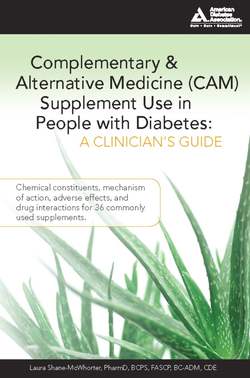Читать книгу Complementary and Alternative Medicine (CAM) Supplement Use in People with Diabetes: A Clinician's Guide - Laura Shane-McWhorter - Страница 6
На сайте Литреса книга снята с продажи.
1. Introduction
ОглавлениеMedical journals, the lay press, and the Centers for Disease Control and Prevention have highlighted the ever-increasing number of diabetes cases, now exceeding 20 million in the U.S.1 Although there are numerous conventional, or allopathic, therapies to treat diabetes, there is also a tremendous interest in emerging therapies, including nontraditional, or complementary and alternative, medicine. Complementary and alternative medicine therapeutic modalities have become increasingly popular, and it is estimated that consumers spent $17.7 billion dollars on oral supplements in 2001.2
Two distinct definitions of these unique therapies are important for clinicians to differentiate. One is the definition of complementary and alternative medicine (CAM) and the other is the definition of dietary supplements. The National Center for Complementary and Alternative Medicine (NCCAM) has provided a definition of complementary and alternative medicine. NCCAM states that CAM therapies cover a broad range of healing philosophies, approaches, and treatments. CAM is defined by NCCAM as treatments and health care practices not widely taught in medical schools, not generally used in hospitals, and not usually reimbursed by insurance companies.3 In CAM therapy, the health care practitioner considers the whole person, including not only physical, mental, and emotional characteristics, but also spiritual aspects. Hence the term “holistic” is used to characterize treatment. Some of these therapies are used alone and referred to as “alternative.” Other therapies are combined with other alternative or conventional therapies and referred to as complementary.3 NCCAM has categorized CAM into four different domains: biologically based therapies, mind-body medicine, energy medicines, and manipulation and body-based practices.
Biologically based therapies include the use of herbs and dietary supplements. Oral CAM therapies may include botanical products or nonbotanical products such as vitamins and minerals, and are sometimes referred to as “dietary supplements.” A definition of dietary supplements has been provided by the Dietary Supplement Health and Education Act of 1994.4 A dietary supplement is “a product taken by mouth that contains a “dietary ingredient” intended to supplement the diet and may include vitamins, minerals, herbs or other botanicals, amino acids, enzymes or glandulars, or some type of concentrate, metabolite, or extract.”5
Thus, CAM therapies have included dietary supplements (herbals and vitamins) and other treatments such as acupuncture, relaxation techniques, massage, chiropractic, and spiritual healing.6 In diabetes, certain types of CAM therapies that have been considered useful include not only herbal and homeopathic products but also certain diets, acupuncture, energy healing, biofeedback, hypnotherapy, reflexology, massage therapy, and yoga.7
This book will use the term “CAM supplements” to describe nontraditional oral agents that are of botanical or nonbotanical origin. Hundreds of different plant species have been recorded as being useful to treat diabetes.7,8 Indeed, metformin is a biguanide that is widely prescribed in patients with type 2 diabetes, and this class of agents is related to Galega officinalis L., or goat’s rue,9 which was used for many centuries to treat diabetes. There are also numerous nonbotanical products that patients have used to treat diabetes.
Unfortunately many clinical studies that have assessed the use of CAM supplements are limited in number or are fraught with design problems. Yet clinicians involved in the care of patients with diabetes often encounter patients who are using these supplements. Instead of simply telling patients not to use these products, it is important to respect the patient’s health beliefs and address his or her questions in an unbiased manner. It is imperative that clinicians learn about CAM supplements their patients may be taking concurrently with prescribed medications for diabetes, related comorbidities, or other disease states. Clinicians may then advise their patients and discuss CAM product use in an open manner. Clinicians who provide medical care for diabetes patients must learn about the potential use, adverse effects, and drug-drug or drug-disease interactions produced by these supplements. It is also important for clinicians to access accurate sources to provide information to their patients. The intent of this book is to provide information that may help clinicians learn about CAM supplements often used by patients with diabetes. It is also important for clinicians to maintain an open mind and be considerate of their patients” wishes.
